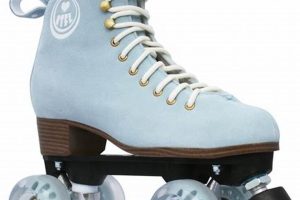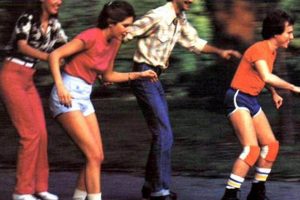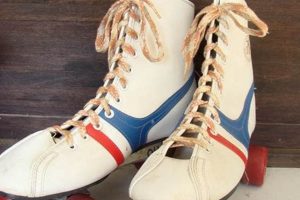These specialized skating devices allow users to traverse varied terrains beyond smooth, paved surfaces. Featuring pneumatic tires or similarly robust wheel designs, they provide enhanced shock absorption and grip compared to traditional inline or quad skates. These skates offer a unique method of outdoor recreation and fitness, expanding the possibilities of skating beyond conventional environments.
The appeal of skates designed for rough or unpaved trails lies in the freedom to explore new landscapes and experience skating in a more adventurous way. They offer a full-body workout, engaging core muscles for balance and leg muscles for propulsion. The historical context involves the evolution of skating technology to meet the demands of diverse environments, moving beyond the limitations of smooth, prepared surfaces. This progression has opened avenues for cross-training for athletes and a novel form of outdoor leisure.
The subsequent sections will delve into the key features differentiating these skates from their standard counterparts, factors to consider when selecting a pair, and optimal techniques for mastering the art of skating on challenging terrains.
Guidance for Utilizing All-Terrain Skates
Optimal use of skates designed for varied surfaces requires consideration of several factors. These include equipment selection, proper technique, and awareness of environmental conditions. Adherence to these guidelines will enhance the user experience and minimize potential risks.
Tip 1: Selection of Appropriate Equipment: The choice of skate must align with the intended terrain. Pneumatic tires offer superior shock absorption for rough trails, while harder compounds may suffice for smoother, unpaved surfaces. Boot support and ankle stability are crucial for preventing injuries.
Tip 2: Pre-Skate Inspection: Prior to each use, a thorough inspection of the skates is imperative. This includes checking tire pressure, ensuring all fasteners are secure, and verifying the functionality of braking mechanisms.
Tip 3: Gradual Progression: New users should begin on relatively flat, stable surfaces to develop fundamental skills. As proficiency increases, progressively more challenging terrains can be explored. Avoid steep inclines or excessively rough areas until adequate control is established.
Tip 4: Mastering Braking Techniques: Effective braking is paramount for safety. Practice various braking methods, such as T-stops or heel brakes, to ensure competence in diverse situations. Anticipate potential hazards and initiate braking maneuvers well in advance.
Tip 5: Maintaining Proper Posture: A balanced stance is essential for stability and control. Maintain a slight bend in the knees, keep the core engaged, and distribute weight evenly. Avoid leaning excessively forward or backward, as this can compromise balance.
Tip 6: Terrain Awareness: Scan the path ahead for obstacles, such as rocks, roots, or potholes. Adapt skating technique accordingly, adjusting speed and trajectory to navigate challenging sections safely. Be mindful of changes in surface conditions, particularly when transitioning between different types of terrain.
Tip 7: Protective Gear Usage: Helmets, knee pads, elbow pads, and wrist guards are non-negotiable. These protective measures significantly reduce the risk of injury in the event of a fall. Ensure that all gear fits properly and is in good condition.
By adhering to these recommendations, individuals can maximize the enjoyment and minimize the risks associated with skating on non-traditional surfaces. Safety, informed equipment selection, and progressive skill development are essential components of a positive experience.
The following sections will expand upon specific technical aspects of skating on these skates and provide further insights into advanced techniques.
1. Pneumatic Tire Inflation
Pneumatic tire inflation is a critical determinant of performance and user experience when utilizing skates on unpaved surfaces. The inflation pressure directly influences tire contact area, which subsequently impacts traction and rolling resistance. Lower inflation pressures increase the contact patch, enhancing grip on loose surfaces such as dirt or gravel. Conversely, higher pressures reduce contact, leading to lower rolling resistance on harder surfaces but potentially decreasing traction. Incorrect inflation can compromise stability and control, particularly on uneven terrain.
The selection of optimal inflation pressure is contingent upon factors like rider weight, terrain type, and tire specifications. Real-world examples underscore this: A heavier individual skating on a soft, sandy trail may benefit from slightly higher tire pressure to prevent excessive sinking and maintain rolling efficiency. A lighter skater on a rocky path, however, might prefer lower pressure for increased shock absorption and improved contact with uneven ground. Tire manufacturers typically provide recommended pressure ranges, serving as a starting point for personalized adjustment. Furthermore, ambient temperature can impact tire pressure, requiring adjustments during seasonal changes. Improper inflation could potentially result in tire damage, such as pinch flats, or compromise handling characteristics, leading to loss of control.
Understanding the relationship between pneumatic tire inflation and surface characteristics is fundamental for anyone engaging in skating beyond paved surfaces. The ability to adjust tire pressure according to specific conditions enhances performance, comfort, and safety. This knowledge is essential for maximizing the capabilities of the skates and mitigating potential risks associated with varied terrains. Regular monitoring and adjustment of tire pressure are therefore integral components of responsible equipment maintenance and safe skating practices.
2. Boot & Ankle Support
The structural integrity of boots and the degree of ankle support significantly influence the control and safety during use of skates designed for uneven surfaces. Insufficient support can lead to instability, increasing the risk of ankle sprains and other injuries. The rugged terrain for which these skates are designed often presents unpredictable lateral forces, necessitating robust support mechanisms within the boot structure. A well-designed boot effectively transfers energy from the skater’s body to the skate’s frame and wheels, enhancing maneuverability and responsiveness.
Construction material and design are crucial determinants of support effectiveness. Stiffer materials, such as reinforced polymers or carbon fiber composites, offer greater rigidity and resistance to deformation. High-cut boot designs provide more extensive coverage and restraint to the ankle joint, mitigating excessive movement. Lacing systems, buckles, and power straps further contribute to securing the foot within the boot and optimizing support. A poorly designed boot will lead to energy loss, reduced control, and increased fatigue, rendering the skates less effective on demanding terrain. For example, a skater attempting a downhill run on a gravel path with inadequate ankle support is at a substantially higher risk of losing control compared to one with a properly supportive boot.
Adequate boot and ankle support are not merely desirable features but critical requirements for skating safely and effectively on irregular surfaces. The ability to confidently navigate diverse terrains hinges on the boot’s capacity to maintain stability and prevent injury. Investment in skates with high-quality boot construction and comprehensive ankle support is essential for those seeking to maximize performance and minimize risks associated with off-pavement skating.
3. Terrain Adaptability Range
The ability of skates designed for varied surfaces to effectively navigate different landscapes is directly proportional to their terrain adaptability range. This range is defined by the types of surfaces on which the skates can maintain stability, control, and traction. A limited range restricts the user to relatively uniform or less challenging environments, diminishing the core purpose of these skates. Conversely, a broad adaptability range allows exploration of diverse terrains, from smooth dirt paths to more rugged gravel trails, thereby maximizing the utility and enjoyment derived from the equipment.
Factors contributing to a wide adaptability range include tire type and pressure, wheel size, and suspension systems (if present). For example, pneumatic tires with adjustable pressure allow modification of the contact patch to suit varying surface conditions. Larger wheel diameters can roll more efficiently over obstacles and rough surfaces, while suspension systems absorb shocks and maintain wheel contact. Skates intended for primarily flat, compacted trails require less aggressive tire treads and suspension than those designed for rocky, uneven terrain. Choosing skates with an appropriate adaptability range depends on the user’s anticipated skating environments and desired level of challenge. The consequence of inadequate adaptability manifests as reduced control, increased fatigue, and potential for equipment damage. An example: Utilizing skates with small, hard wheels on a heavily rutted trail would result in a jarring ride, diminished traction, and a higher risk of wheel failure.
In summation, terrain adaptability range is a key performance indicator for these specialized skates. A greater range allows for wider exploration possibilities, while a limited range restricts functionality. Understanding the factors that influence adaptability, such as tire characteristics and suspension, is crucial for selecting the appropriate equipment and ensuring a safe and enjoyable skating experience on diverse surfaces. The selection process requires careful consideration of intended usage and the prevailing terrain characteristics.
4. Braking Mechanism Efficiency
Effective braking is paramount for the safe and controlled operation of skates designed for off-pavement use. The varied and often unpredictable nature of these environments necessitates braking systems capable of delivering consistent and reliable deceleration. Braking mechanism efficiency, therefore, is a critical consideration in the selection and application of these specialized skating devices.
- Braking Force Modulation
The ability to modulate braking force is essential for adapting to changing surface conditions. Off-road surfaces often exhibit varying levels of grip, requiring precise control over braking pressure to prevent skidding or loss of control. A system offering fine-tuned modulation allows the skater to maintain directional stability and optimize stopping distance. For example, a skater encountering a patch of loose gravel must be able to reduce braking force incrementally to avoid locking the wheels and losing traction.
- Heat Dissipation Capacity
Prolonged braking, particularly on steep descents, generates significant heat. Efficient heat dissipation is crucial to prevent brake fade, a phenomenon where braking effectiveness diminishes due to overheating. Systems incorporating features like ventilated rotors or larger braking surfaces are better equipped to manage heat buildup and maintain consistent performance. A skater descending a long, winding trail relies on the braking system’s ability to dissipate heat to ensure consistent stopping power throughout the descent.
- Durability and Resistance to Contaminants
Off-road environments expose braking systems to a range of contaminants, including dirt, mud, and water. Braking components must be durable and resistant to these elements to maintain reliable operation. Sealed bearings, corrosion-resistant materials, and robust designs are crucial for preventing contamination-related failures. Consider a scenario where skates are used in muddy conditions; a braking system vulnerable to debris accumulation could experience reduced effectiveness or even complete failure.
- System Maintenance Requirements
The complexity and frequency of maintenance required for a braking system can significantly impact its long-term efficiency. Systems requiring frequent adjustments or specialized tools may be less practical for skaters who frequently venture into remote locations. A well-designed system should be relatively easy to inspect, clean, and maintain to ensure consistent performance. For example, a braking system with easily replaceable pads and accessible adjustment points simplifies routine maintenance and prolongs its service life.
In conclusion, braking mechanism efficiency is a multifaceted characteristic that directly influences the safety and usability of skates designed for use on challenging terrains. Features such as force modulation, heat dissipation, durability, and maintenance requirements all contribute to the overall effectiveness of the braking system and its ability to provide reliable stopping power in diverse conditions. Selecting skates with a braking system that aligns with the intended use and environmental conditions is paramount for maximizing safety and control.
5. Bearing Durability Factors
Bearing durability is a critical performance parameter for skates intended for surfaces other than pavement. The operational environment of off-road skates inherently exposes bearings to abrasive contaminants such as dirt, sand, and moisture, accelerating wear and compromising performance. Premature bearing failure directly translates to reduced rolling efficiency, increased physical exertion for the user, and potential safety hazards. The materials used in bearing construction, the effectiveness of sealing mechanisms, and the frequency of maintenance are all significant factors influencing bearing lifespan in these demanding conditions. For example, stainless steel bearings exhibit superior corrosion resistance compared to standard carbon steel bearings, making them more suitable for wet or muddy environments. Similarly, bearings with rubber seals provide a more robust barrier against contaminant ingress compared to open or shielded bearings. Neglecting regular cleaning and lubrication exacerbates the effects of contamination, leading to increased friction, heat generation, and ultimately, bearing failure.
The choice of bearing type and the implementation of appropriate maintenance protocols directly impact the long-term usability and cost-effectiveness of skates designed for rough terrains. Ceramic hybrid bearings, while more expensive, offer advantages in terms of reduced friction and increased resistance to heat and corrosion. Regular cleaning with appropriate solvents and re-lubrication with a high-quality lubricant specifically formulated for bearings can significantly extend bearing life. The cost savings associated with prolonged bearing lifespan often outweigh the initial investment in higher-quality bearings and diligent maintenance practices. The absence of proper maintenance results in a progressive decline in performance, characterized by increased rolling resistance, audible noise, and eventually, bearing seizure. This degradation not only detracts from the skating experience but also poses a safety risk, as seized bearings can impede wheel rotation and compromise stability.
In summary, bearing durability is a fundamental aspect of off-road skate performance, influencing efficiency, safety, and long-term operational costs. The selection of appropriate bearing materials and sealing mechanisms, coupled with consistent and meticulous maintenance, is crucial for mitigating the detrimental effects of environmental contaminants and maximizing bearing lifespan. Failure to address these factors leads to accelerated wear, reduced performance, and increased risk of equipment failure, underscoring the importance of understanding and addressing bearing durability factors in the context of skating on surfaces other than pavement.
Frequently Asked Questions
This section addresses common inquiries regarding specialized skating equipment designed for traversing unpaved surfaces, providing detailed answers to enhance understanding and inform decision-making.
Question 1: Are these skates suitable for all types of off-road terrain?
The suitability varies depending on the specific design features. Skates with larger pneumatic tires and robust suspension systems are better equipped to handle rougher terrains, such as gravel paths and moderately uneven trails. However, extremely rocky or steep terrain may require specialized equipment beyond the capabilities of standard skates designed for unpaved surfaces.
Question 2: What safety precautions are necessary when using these skates?
Wearing appropriate protective gear, including a helmet, knee pads, elbow pads, and wrist guards, is essential. A thorough pre-skate inspection of the equipment is also crucial, ensuring proper tire inflation and secure fasteners. Furthermore, skaters should start on relatively flat, stable surfaces to develop proficiency before attempting more challenging terrains.
Question 3: How does the maintenance differ from standard inline or quad skates?
These skates require more frequent cleaning and lubrication due to increased exposure to dirt and debris. Tire pressure should be regularly checked and adjusted. Bearings may require more frequent replacement or cleaning, depending on usage and environmental conditions. Specialized lubricants designed for bearings used in harsh conditions are recommended.
Question 4: What factors should be considered when selecting a pair of these skates?
Key factors include tire type and size, boot and ankle support, braking mechanism efficiency, and overall durability. The intended terrain and skill level of the skater should also be considered. Pneumatic tires provide better shock absorption, while robust ankle support is crucial for stability on uneven surfaces. A reliable braking system is essential for safe deceleration.
Question 5: Can standard skating techniques be applied to these skates?
While fundamental skating skills are transferable, certain techniques require modification. Braking distances may be longer on unpaved surfaces, and adjustments to balance and posture are necessary to maintain stability on uneven terrain. Practicing in a controlled environment is recommended to adapt to the unique handling characteristics.
Question 6: Are these skates suitable for beginners?
While experienced skaters may adapt quickly, beginners should exercise caution. Starting on smooth, flat surfaces and gradually progressing to more challenging terrain is recommended. Prior skating experience is beneficial but not mandatory. Emphasizing safety and fundamental skills development is essential for novice users.
This FAQ section provides foundational information for individuals considering or currently using specialized skating equipment designed for off-pavement conditions. Safety, proper equipment selection, and adherence to maintenance protocols are paramount for a positive and secure skating experience.
The next section will explore advanced techniques and considerations for maximizing performance and enjoyment while using off road skates.
Conclusion
This exposition has outlined the defining characteristics, operational considerations, and maintenance requirements associated with these specialized skates. The discussion encompassed critical aspects such as tire inflation, boot support, terrain adaptability, braking efficiency, and bearing durability. A thorough understanding of these elements is paramount for safe and effective utilization of skating devices on unpaved surfaces.
The evolution of skating continues to expand the boundaries of recreational and athletic pursuits. Informed selection, diligent maintenance, and a commitment to safety will ensure that individuals can fully appreciate the unique capabilities offered by skating beyond the confines of traditional paved environments. As technology advances, one can anticipate further refinements in skate design, expanding the possibilities for all-terrain exploration and enhancing the user experience.







